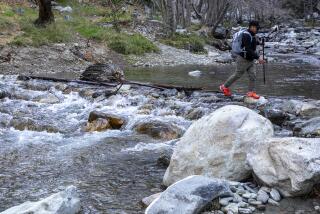A Hot Creek Saunter and Soak
- Share via
A soothing soak, fabulous fly-fishing and an up-close look at one of California’s most intriguing geothermal areas are highlights of a hike along Hot Creek near Mammoth Lakes. If hot springs, hiking and trout aren’t reasons enough for a visit, Hot Creek has one more attraction: a long hiking season.
Hot Creek Trail is the very last Mammoth-area path to be snow-covered in winter and the very first to be snow-free in spring.
While “Hot Creek” might suggest a place for cooking fish, not catching them, fly-fishers revere the creek, which consistently ranks among the top five watercourses in California. It seems Hot Creek’s open-to-the-sunlight setting and unusually warm waters (85 to 95 degrees) create optimal conditions for the growth of the kind of underwater vegetation (i.e., fish food and habitat) preferred by trout. The terrific fly-fishing here is strictly for sport and of the catch-and-release variety.
The headwaters of Hot Creek are anything but hot; its waters rise as Mammoth Creek, high in the Sierra by Mammoth Lakes Basin. After descending to the high desert floor, Mammoth Creek is joined by a large hot spring that gushes into the cool Sierra stream and transforms it into Hot Creek. After percolating through a geothermal area, Hot Creek flows a few more miles east through the wide-open, sagebrushy spaces to empty into the Owens River near Crowley Lake.
The U.S. Forest Service at Inyo National Forest has done a fine job of providing trail-side amenities: restrooms, changing rooms for bathers, a picnic area, plus interpretive signs that explain how volcanic action of long ago and underground forces of today put the “hot” in Hot Creek.
Just in case anyone leaves all good sense behind in the parking lot, the Forest Service has built lots of fencing and posted lots of signs to discourage you from plopping into those sections of Hot Creek where the water is boiling.
Observing a few simple precautions will make your Hot Creek outing memorable for all the right reasons. Stay on the trail and remember that the footbridge is the only place to cross Hot Creek. Bathe only in the big, open, warm-but-not-scalding areas in the middle of the creek.
You are likely to lose all motivation and momentum for a hike if you slip into the soothing waters right away. I recommend hiking first, soaking second.
Directions to trail head: From California 395, about 35 miles north of Bishop and just three miles south of California 203 (the road to Mammoth), turn east on Hot Creek Hatchery Road and travel three miles to the parking area for Hot Creek Geological Site.
The hike: Stairs and 0.1 mile of paved path aid your descent to the creek. Your nose will confirm that you’re proceeding in the right direction as the characteristic smell of sulfur wafts your way.
Take the footbridge over to the north bank of Hot Creek and head west (left) on the trail. You’ll likely spot groups of semi-submerged soakers as well as fly-fishers on the south side of the creek.
Travel a mile or so up-creek through the narrow Hot Creek Gorge and savor the view of the snowcapped, two-mile-high Sierra peaks to the west. Ambitious hikers can walk almost all the way to Hot Creek Fish Hatchery, but most will find the prospect of relaxing in Hot Creek more compelling.
Hot Creek Springs Trail
WHERE: Hot Creek Geological Site.
DISTANCE: 2 miles round trip with 100-foot elevation gain.
TERRAIN: Banks of Hot Creek, an active geothermal area.
HIGHLIGHTS: Soothing soak, great fly-fishing.
DEGREE OF DIFFICULTY: Easy.
PRECAUTIONS: Heed all warning signs and use common sense around the hot waters of Hot Creek.
FOR MORE INFORMATION: Mammoth Ranger District, Inyo National Forest, P.O. Box 148, Mammoth Lakes, CA 93546; tel. (760) 924-5500.
More to Read
Sign up for The Wild
We’ll help you find the best places to hike, bike and run, as well as the perfect silent spots for meditation and yoga.
You may occasionally receive promotional content from the Los Angeles Times.






